Lenz’s Law of Electromagnetic Induction
What is Lenz’s Law?
Lenz’s law of electromagnetic induction states that the direction of the current induced in a conductor by a changing magnetic field (as per Faraday’s law of electromagnetic induction) is such that the magnetic field created by the induced current opposes the initial changing magnetic field which produced it. The direction of this current flow is given by Fleming’s right hand rule.
This can be hard to understand at first – so let’s look at an example problem. Remember that when a current is induced by a magnetic field, the magnetic field that this induced current produces will create its own magnetic field. This magnetic field will always be such that it opposes the magnetic field that originally created it. In the example below, if the magnetic field “B” is increasing – as shown in (1) – the induced magnetic field will act in opposition to it.
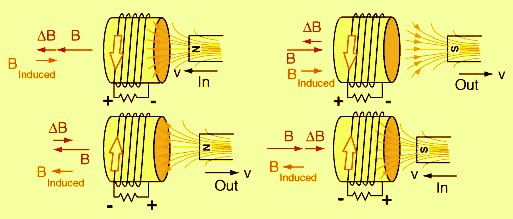
When the magnetic field “B” is decreasing – as shown in (2) – the induced magnetic field will again act in opposition to it. But this time ‘in opposition’ means that it is acting to increase the field – since it is opposing the decreasing rate of change.
Lenz’s law is based on Faraday’s law of induction. Faraday’s law tells us that a changing magnetic field will induce a current in a conductor. Lenzs law tells us the direction of this induced current, which opposes the initial changing magnetic field which produced it. This is signified in the formula for Faraday’s law by the negative sign (‘–’).

This change in the magnetic field may be caused by changing the magnetic field strength by moving a magnet towards or away from the coil, or moving the coil into or out of the magnetic field. In other words, we can say that the magnitude of the EMF induced in the circuit is proportional to the rate of change of flux.

Lenz’s Law Formula
Lenz’s law states that
When an EMF is generated by a change in magnetic flux according to Faraday’s Law, the polarity of the induced EMF is such, that it produces an induced current whose magnetic field opposes the initial changing magnetic field which produced it.
The negative sign used in Faraday’s law of electromagnetic induction, indicates that the induced EMF (ε) and the change in magnetic flux (δΦB) have opposite signs. The formula for Lenz’s law is shown below:
![]()
Where:
- ε = Induced emf
- δΦB = change in magnetic flux
- N = No of turns in coil
Explanation of Lenz’s Law :
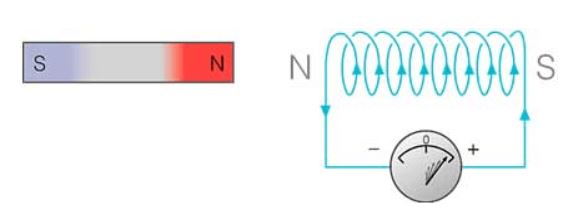
When the north pole of the magnet is approaching towards the coil, the magnetic flux linking to the coil increases. According to Faraday’s law of electromagnetic induction, when there is a change in flux, an EMF, and hence current is induced in the coil and this current will create its own magnetic field.
Now according to Lenz’s law, this magnetic field created will oppose its own or we can say opposes the increase in flux through the coil and this is possible only if approaching coil side attains north polarity, as we know similar poles repel each other. Once we know the magnetic polarity of the coil side, we can easily determine the direction of the induced current by applying right hand rule. In this case, the current flows in the anticlockwise direction.
Case 2: When a magnet is moving away from the coil
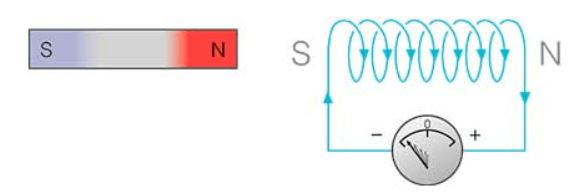
When the north pole of the magnet is moving away from the coil, the magnetic flux linking to the coil decreases. According to Faraday’s law of electromagnetic induction, an EMF and hence current is induced in the coil and this current will create its own magnetic field.
Now according to Lenz’s law, this magnetic field created will oppose its own or we can say opposes the decrease in flux through the coil and this is possible only if approaching coil side attains south polarity, as we know dissimilar poles attract each other. Once we know the magnetic polarity of the coil side, we can easily determine the direction of the induced current by applying right hand rule. In this case, the current flows in a clockwise direction.
Note that for finding the directions of magnetic field or current, use the right-hand thumb rule i.e if the fingers of the right hand are placed around the wire so that the thumb points in the direction of current flow, then the curling of fingers will show the direction of the magnetic field produced by the wire.
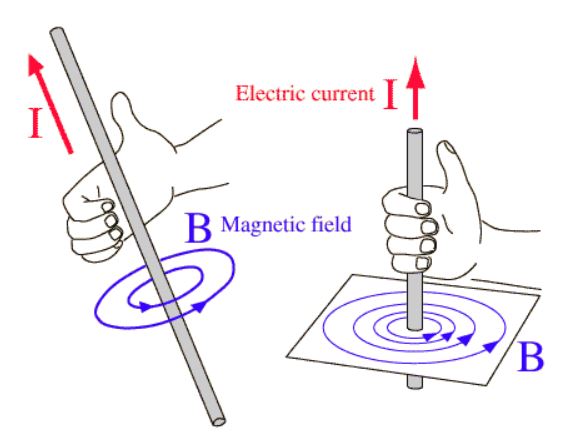
Lenzs law can be stated as follows:
- If the magnetic flux Ф linking a coil increases, the direction of current in the coil will be such that it will oppose the increase in flux and hence the induced current will produce its flux in a direction as shown below (using Fleming’s right-hand thumb rule)

- If magnetic flux Ф linking a coil is decreasing, the flux produced by the current in the coil is such, that it will aid the main flux and hence the direction of current is as shown below.
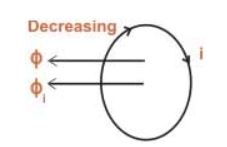
Lenz’s Law Applications
The applications of Lenz’s law include:
- Lenz’s law can be used to understand the concept of stored magnetic energy in an inductor. When a source of emf is connected across an inductor, a current starts flowing through it. The back emf will oppose this increase in current through the inductor. In order to establish the flow of current, the external source of emf has to do some work to overcome this opposition. This work can be done by the emf is stored in the inductor and it can be recovered after removing the external source of emf from the circuit
- This law indicates that the induced emf and the change in flux have opposite signs which provide a physical interpretation of the choice of sign in Faraday’s law of induction.
- Lenz’s law is also applied to electric generators. When a current is induced in a generator, the direction of this induced current is such that it opposes and causes rotation of generator (as in accordance with Lenz’s law) and hence the generator requires more mechanical energy. It also provides back emf in the case of electric motors.
- Lenz’s law is also used in electromagnetic braking and induction cooktops.
Read article –Faraday’s law of electromagnetic induction
Visit NCERTplanet.com for NCERT solutions and Textbook downloads



